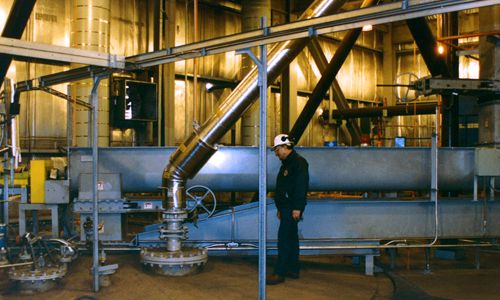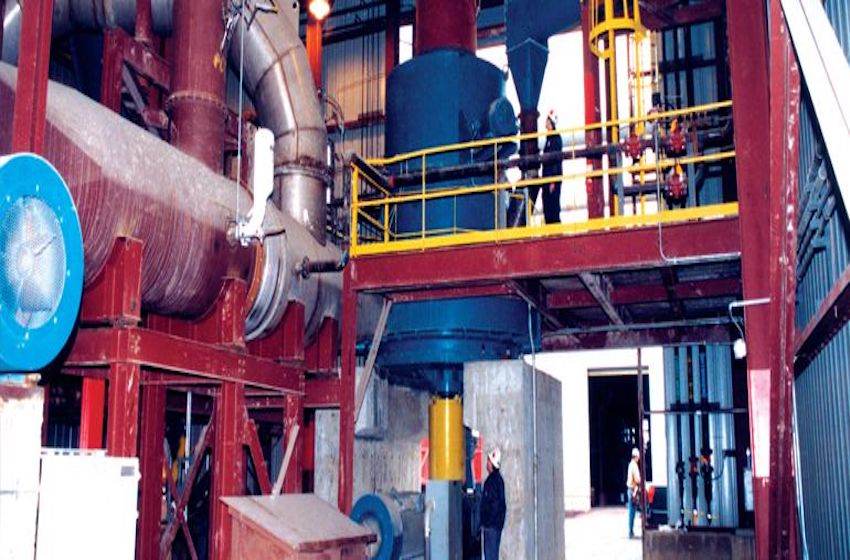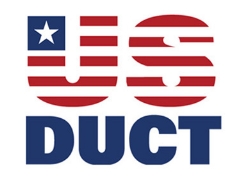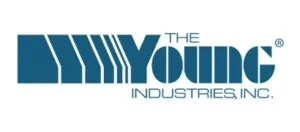
Industrial Roller Mills
Williams Patent Crusher designs and manufactures high-quality industrial roller mills that consistently deliver a uniform grind for almost any material. It is our goal to provide a machine that offers a better value for our customers while still being a powerful piece of machinery.
One of the key components of the Williams vertical roller mills is the customization options that are available. Since our industrial roller mills are used for a wide range of applications and material size reduction, our machines allow for custom feeder selection to ensure a high-capacity, trouble-free operation no matter what kind of material you need reduced.
Take a look through the industrial roller mill features and operation system of the machine to see how the cutting-edge design makes Williams Crusher the leading roller mill manufacturer in the world.
Why Choose Williams as Your Roller Mill Manufacturer
Williams has been the industry leader for crushing and pulverizing machines since 1871. All of our machines are innovative and designed to be rugged and dependable.
Our team sets itself apart with a diverse product line and customized systems for a variety of applications. The Williams roller mill is a perfect example of the kind of versatility our engineers infuse into all of our machines. Built to last and applicable to a variety of uses from limestone and clay to gypsum and coal is what makes the roller mills and all Williams designs stand out from the pack.
What is a Roller Mill Used For?
Centrifugal roller mills use the centrifugal force of cylindrical grinding rolls to crush material into a uniform particle size and grind, turning materials into small granules or fine powder. Some of its typical applications include the particle size reduction of coal, glass, gypsum, limestone, and more.
Simultaneous Grinding and Drying
Williams roller mills can perform simultaneous grinding and drying functions with one continuous operation. The roller mills simultaneous grinding and drying features are typically for materials with higher moisture such as limestone and clay. Learn more about the Williams machines capable of simultaneous grinding and drying functions.
Features of the Roller Mill
Williams Patent Crusher: The Acknowledged Leader in Fluid Bed Roller Mill Design
Roller mills are industrial mills that uses cylindrical rollers to crush and grind material instead of flat plates like other pulverizers. The Williams Roller Mills are designed to provide years of reliable, consistent, and efficient operation, but the reason why Williams is one of the leading roller mill manufacturers is their ease of use and maintenance.
Learn more about the features of the Williams vertical roller mill to see why it should be your top choice.
1. Product Control: Micrometer control of finished product. Product size (regardless of turn down or grinding element wear) is controlled by utilizing the Williams High Efficiency Turbine Separator equipped with a variable speed drive. Drive adjustment is controlled automatically from centralized control panel.
2. Fluidized Bed Drying: Hot gas entering the grinding chamber below the grinding rolls fluidizes the entire grinding chamber. This promotes rapid efficient drying of all material types, including lignite and sorbent. Large open area through grinding chamber allows particle terminal velocities to be maintained while fluidized by heated gasses.
3. External Gear Box: External right angle gear box eliminates damage from heat and contamination of product into gear box. Removal of gear box from skid allows change out of main vertical shaft.
4. Turn Down Ratio: Nearly infinite turn down while maintaining product size. Williams adjusts the mill grinding rate as a direct function of control system demand. The mill capacity is modulated by varying mill speed.
5. Mill Speed: Mill speed modulation varies the centrifugal force of the grinding rolls. Product capacity ranges from 100% to 0% utilizing an optional variable frequency A.C. drive.
6. Bottom Discharge: Auxiliary Mill Bottom Discharge permits production of a second granular product or beneficiation of the principal product by the removal of pyrites and tramp material, either can be done simultaneously with fine grinding and drying.
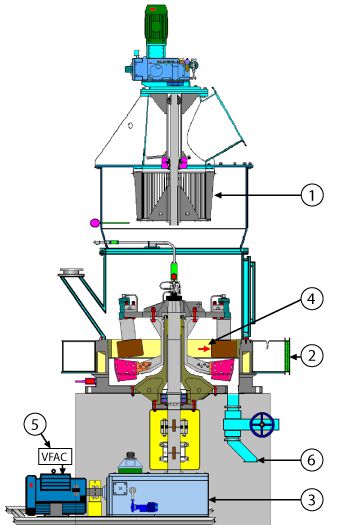
How Do Industrial Roller Mills Work?
The Williams centrifugal roller mills were designed with efficiency in mind. Each part works in tandem to efficiently dry, grind, and classify material. Learn more about how industrial roller mills work when they are designed by the experts at Williams.
See the diagram to the right to see how a roller mill works and reference the specific parts labeled below:
A. Feeder
B. Base of the Roller Mill
C. Centrifugal Main Mill Fan
D. High Efficiency Turbine Separator
E. Cyclone Collector
F. Fabric Collector
G. Heater
H. Recycle Line
K. Discharge Spout
Operation of the Williams Roller Mill System is completely automatic.
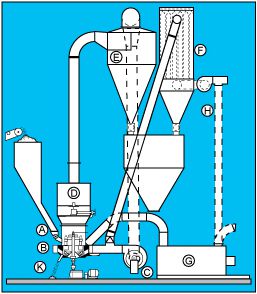
The feeder (A) introduces raw material into the grinding chamber in the base of the Roller Mill (B) at a rate determined by pressure variations with the grinding mill. Plows located ahead of each roller direct the material upward and between the grinding rolls and the heavy alloy steel bull ring where it is ground to size. The grinding rolls are free to swing out centrifugally which forces them to bear upon and grind the raw material. Being free to pivot, the rolls automatically assume the proper position for grinding and need no adjustment to compensate for wear.
Once ground to size, material is swept out of the mill by the controlled air flow from the centrifugal main mill fan (C). Air suspended, the ground material passes through the adjustable Williams High Efficiency Turbine Separator (D). In the separator, an accurate size classification is made which allows product size material to be conveyed away from the grinding mill while oversize material is returned for additional grinding. Product sized material is removed from the airstream by the Cyclone Collector (E). Typically, a conveyor or product storage bin will be located to accept the product as it exits from the bottom of the Cyclone Collector.
Fabric Collector (F): Airborne fines which remain entrained in the exhaust gas from the Cyclone Collector are removed by a high efficiency fabric dust collector located downstream from the cyclone. The efficiency of the basic Roller Mill System becomes a highly efficient means of removing moisture from the raw material by the simple addition of an air heater (G) as shown in color.
Further refinements to the heater system allow the Williams Roller Mill to process hazardous dusts in a controlled low oxygen atmosphere. A recycle line (H) from the dust collector to the heater enables a further reduction in oxygen level. This is Williams’ patented Inert Gas System.
Product beneficiation is possible in the Williams Roller Mill System by continuous removal of impurities through a discharge spout (K) located beneath the grinding mill.
Key Components of the Williams Industrial Roller Mill
The Williams team took great care when designing each component of our industrial roller mills. Learn how each part of the roller mill works to create consistent, uniform product with maximized efficiency from the primary and secondary fans to the air heater.
A. Primary and Secondary Fans provide the fluidizing and conveying of the product and removal of moisture from the system.
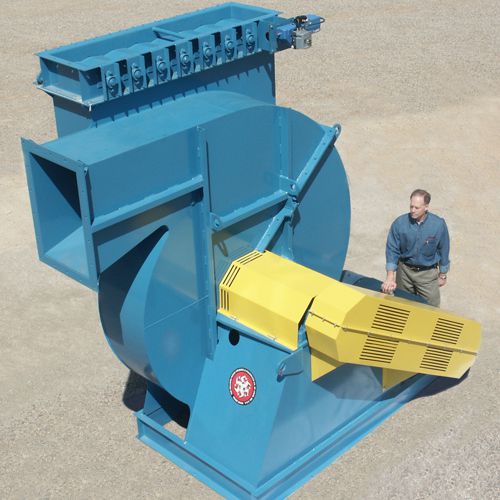

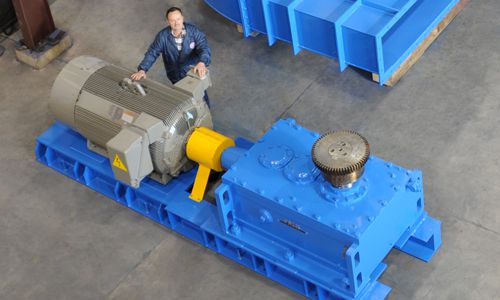
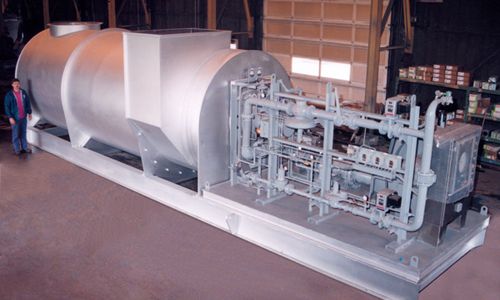

Feeders for Vertical Roller Mills
Williams industrial roller mills are used for a wide range of applications and materials, which means that the proper feeder selection is essential for high-capacity, trouble-free operation and more efficient production.
You can customize your vertical roller mill depending on what material you need reduced. Learn more about the different types of feeders that can be furnished to fit Williams roller mills. Or, contact the Williams team today to discuss your specific customization requirements for one of our roller mills.


